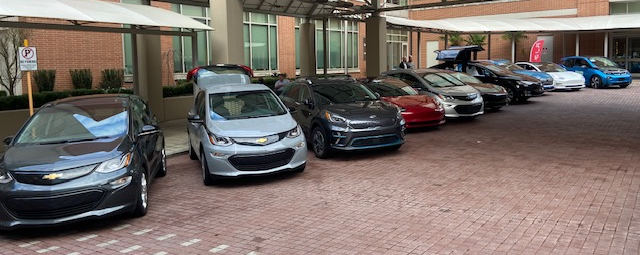With record-setting gasoline prices across the nation, an increasing number of drivers are considering electric vehicles (EVs). Searches for new plug-in hybrid and all-electric vehicles are at record levels, increasing by over 60% since the beginning of March according to a report by MarketWatch. Unfortunately, global supply chain issues are making it more difficult to make the switch.
If you’re considering any new vehicle right now, whether electric or not, you may be facing higher prices and longer wait times right now. We encourage you to expand your search geographically, as the perfect vehicle for you may be available a few towns over. In addition, there are more than 70 models of EVs now available in the U.S., our website PlugStar.com is available to compare all of the different vehicles now available.
Some dealerships still have vehicles available on their lots and are updating their websites daily. Across the nation, there are more than 20,000 EVs available for purchase. With such a hot market, your first step should be to call the seller for availability. More often than not, vehicles will sell within the first few days of being posted online. Our advice: if you see a vehicle that fits within your criteria, don’t wait to reach out.
This is also a great time to consider a pre-owned vehicle. Used EVs have fewer moving parts that can break or fail and they require less maintenance, so you can find a dependable vehicle, such as a Chevy Volt or Nissan LEAF, at a reasonable price. While used EVs may not have the 250+ miles range of new vehicles, they provide a solution to skyrocketing energy costs while still being useful and fun to drive.
Our Used EV Buyer’s Guide also provides a comprehensive list of what to look for when shopping for a pre-owned EV. There are many factors to consider, such as battery health, usable range, and charging options. While EV batteries are known to last the life of the vehicle, a used EV may have less range than when it was new. Using apps like Plugshare or A Better Route Planner will help you find local charging station information and help you plan your charging stops on longer trips.
Recurrent allows you to see a used vehicle’s battery health and compare it to battery health statistics of the same make and model. This is important to make sure that the vehicle you are thinking of purchasing will provide the range you need to drive without worry. Most manufacturers have a lengthy warranty on EV batteries and their related components, usually for around 8-10 years and 100,000 miles. Also, be sure to check with your local state and city municipalities for EV incentives such as reduced electricity rates, tax credits, or rebates to help make the transition to an EV or PHEV easier.
Although buying a new or pre-owned EV in these strange times comes with a unique set of difficulties, it is still possible to find a vehicle that works for you. Once you go electric, you won’t go back!

cheap lasuna generic – buy himcolin online buy himcolin generic
besifloxacin ca – cheap carbocisteine without prescription cheap sildamax without prescription
gabapentin medication – buy gabapentin 100mg for sale order azulfidine for sale
brand celebrex 200mg – indocin 75mg oral purchase indomethacin online
buy cheap generic mebeverine – pletal 100mg drug cilostazol pills
voltaren 100mg pills – cheap diclofenac 100mg order aspirin
rumalaya tablets – order shallaki generic generic endep 10mg
buy generic pyridostigmine – imuran 25mg oral buy imuran pills for sale
buy diclofenac cheap – buy cheap nimodipine buy nimodipine pill
buy baclofen 10mg – piroxicam ca piroxicam 20 mg brand
buy periactin generic – cyproheptadine 4mg canada buy generic zanaflex online
order meloxicam 7.5mg sale – order rizatriptan without prescription ketorolac tablet
trihexyphenidyl tablets – cheap trihexyphenidyl diclofenac gel online purchase
brand cefdinir 300 mg – buy omnicef sale buy generic cleocin for sale
order accutane 20mg pills – buy deltasone without prescription buy deltasone 40mg generic
buy deltasone 20mg sale – buy zovirax online cheap order elimite for sale
purchase acticin sale – permethrin order tretinoin gel over the counter
betamethasone canada – betamethasone 20gm creams order generic benoquin
buy flagyl 200mg – purchase cenforce pill cenforce 50mg pill
order augmentin pill – augmentin tablet order synthroid 100mcg online cheap
cleocin 300mg sale – buy generic indomethacin online indomethacin 75mg drug
losartan 25mg pill – cephalexin 250mg oral cephalexin 500mg brand
buy crotamiton – order mupirocin purchase aczone online
provigil 100mg generic – order melatonin online cheap melatonin cheap
buy bupropion 150 mg generic – buy shuddha guggulu sale where can i buy shuddha guggulu
xeloda 500 mg uk – mefenamic acid usa danazol cost
progesterone 100mg pill – buy clomid for sale fertomid order
buy fosamax 35mg generic – provera 10mg cheap buy medroxyprogesterone pills
estrace 1mg canada – ginette 35 pills arimidex 1 mg sale
order dostinex online cheap – buy dostinex 0.5mg online cheap buy alesse without prescription
гѓ—гѓ¬гѓ‰гѓ‹гѓі еЂ¤ж®µ – г‚ўгѓўг‚г‚·г‚·гѓЄгѓійЂљиІ© г‚ўг‚ёг‚№гѓгѓћг‚¤г‚·гѓійЊ 500mg еј·гЃ•
гѓ—гѓ¬гѓ‰гѓ‹гѓігЃ®иіје…Ґ – гѓ—гѓ¬гѓ‰гѓ‹гѓійЂљиІ© 安全 г‚ўг‚гѓҐгѓ†г‚¤гѓійЊ 40 mg еј·гЃ•
valif pills pig – valif online scrooge order sinemet 10mg
valif move – sinemet 10mg usa order sinemet without prescription
provigil 100mg canada – order lamivudine online cheap buy epivir tablets
phenergan cost – ciprofloxacin 500mg pill lincocin drug
ivermectin oral – order tegretol without prescription carbamazepine 400mg oral
order prednisone sale – starlix price capoten over the counter
buy prednisone 40mg online cheap – deltasone usa captopril 25mg pill
buy cheap isotretinoin – order accutane 20mg buy zyvox 600 mg sale
brand zithromax 500mg – buy zithromax online buy bystolic generic
cheap omnacortil sale – buy progesterone online cheap prometrium 100mg brand
buy furosemide 100mg pill – betamethasone 20gm usa3 buy cheap betamethasone
vibra-tabs for sale online – order monodox for sale glucotrol usa
augmentin 1000mg pill – order nizoral pills buy cheap duloxetine